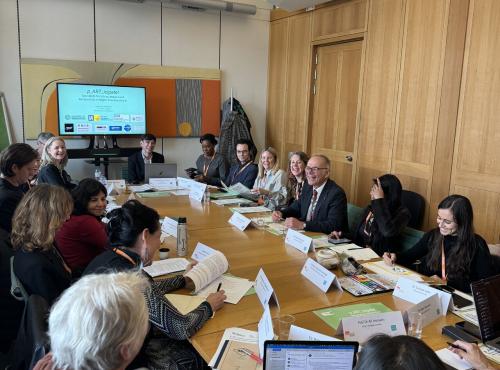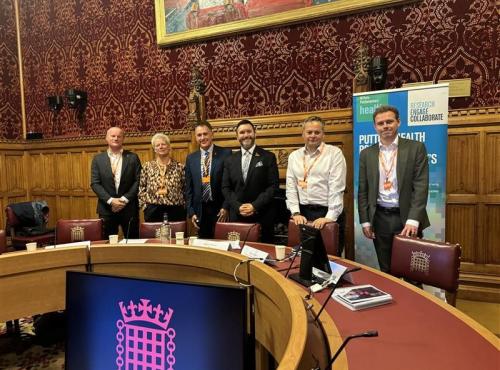Training Tomorrow’s Doctors: What the UK Can Learn from the US
This summer, I’m leading the research phase of a new inquiry for the Higher Education Commission and the All-Party Parliamentary Health Group, exploring how education can help deliver the NHS Long Term Workforce Plan. As part of this work, I’ve been looking at how different countries train their future doctors. A conversation with Dr Matt Morgan—undertaking a university exchange at the University of Wyoming—brought into focus just how different the UK and US medical education models are.
So what is it like to study medicine in the US compared to the UK? What different challenges do students face—and what might each system learn from the other?
The most striking structural difference between the two systems is the point of entry.
In the UK, students apply to medical school straight from school, often at 17 or 18. If successful, they begin a five- or six-year undergraduate course that leads directly into clinical training. In contrast, US students first complete a four-year undergraduate degree—usually in a related subject such as biology or chemistry—before applying to a four-year graduate medical programme. The overall effect: American doctors typically start their clinical careers several years later than their UK counterparts.
UK
Undergraduate entry (age 17-18)
5-6 years of medical school
Applications: UCAT, personal statement, interviews
Funded by student loans & NHS bursary from Year 5
Foundation training (F1/F2) follows graduation
Foundation salary (2025): £38,831 - £44,439
US
Postgraduate entry (after undergraduate degree)
4 years of undergrad + 4 years of med school
Applications: MCAT, GPA, recommendations, interviews
Funded by federal loans, scholarships, personal savings
Residency follows graduation (via Match system)
Residency salary (2025): $60,000-$75,000
The big differences in medical education between the UK and the US are ultimately linked to the broader public and private models of healthcare, and the attitudes to education that come with them. In the UK, medical education is closely woven into the fabric of the National Health Service (NHS), a publicly funded system that views training future doctors as a shared societal responsibility. Over recent years, challenges such as workforce shortages, funding pressures, and rising demand have become pressing political concerns. In response, the UK government has set out ambitious plans—such as the NHS Long Term Workforce Plan—to double medical school places by 2031 and expand the medical workforce through centralised planning. Yet, these efforts are tempered by budget constraints and limited capacity within clinical teaching environments, which strain the ability to increase training opportunities sustainably.
By contrast, the US healthcare system is largely market-driven and decentralised, and this is reflected in its approach to medical education. Funding comes primarily from a mix of federal loans, scholarships, and personal resources, shaped by broader political philosophies favouring deregulation and competition in both healthcare and higher education. The Trump administration’s policies, for example, included proposals to cap federal graduate loans and reduce support to certain higher education institutions deemed elite or inefficient. These moves underline a political shift towards market principles and deregulation, which have intensified concerns around access and student debt within medical training.
These contrasting governmental attitudes—public investment and central planning in the UK, versus a deregulated, market-led approach in the US—provide essential context for understanding the distinct pathways, challenges, and student experiences within each medical education system.
Financial Cost and Its Consequences
Both UK and US medical students face steep financial pressures, but the scale and shape of the challenge differ.
In the US, student debt is a defining feature of medical education. Around two-thirds of graduates leave with debt; nearly half owe more than $150,000. This level of borrowing can significantly influence career choices, pushing students toward higher-paid specialties and away from essential but lower-paid fields like family medicine. Programmes like the National Health Service Corps (NHSC) offer debt relief in exchange for service in underserved areas—but they are limited in scope.
Recent Republican proposals under the Trump administration to cap federal graduate loans were pitched as a way to control tuition inflation. But critics argue these changes risk reducing access for lower-income applicants by forcing them to rely on private lending. The result could be a narrowing of the pipeline into medicine, particularly for students from disadvantaged backgrounds.
In the UK, the cost burden is lighter in numerical terms but still presents significant barriers. Medical students take out tuition and maintenance loans in their early years and receive NHS bursary support from their fifth year onward. But this funding is often inadequate: many students face a steep drop in support after year four, receiving as little as £7,500 per year while on full-time clinical placements. Part-time work is common, but balancing shifts with academic and hospital demands is challenging.
The risk in both systems is the same: that the financial strain deters talented students from underrepresented or lower-income backgrounds and narrows the diversity of the future workforce.
Structure, Certainty, and Flexibility
The UK pathway into medicine is shorter and more direct, but also less flexible. Most students commit to the profession before they’ve had significant experience of it. Alternative routes - like graduate-entry medicine or widening participation programmes like foundation years - are growing but still limited. As a result, students who discover an interest in medicine later in life may find themselves locked out or forced into highly competitive pathways.
The US approach arguably allows for more time and maturity before students commit to medical school. Many students take pre-med tracks as undergraduates, and have more time to gain experience and make informed decisions. This can be beneficial, though there is little direct evidence to prove a causal link between age and performance. What it does offer, however, is time to reflect and explore—and that may contribute to better alignment between students’ values and career paths.
At the same time, the US route comes with more complexity and competition. Entry is fiercely selective, the process is expensive, and there are few guaranteed outcomes.
Matching Systems and Student Stress
In both countries, the transition from medical school to clinical training introduces its own challenges.
In the UK, students enter a two-year Foundation Programme (F1 and F2), with placements allocated via a national algorithm. While students rank their preferred deaneries, final placements depend on a randomised computer algorithm. The process can feel opaque and limiting - especially when deaneries span large and diverse geographies. For example, when I was talking with a Welsh medical student studying in Nottingham she explained that because Wales is its own deanery she can't guarantee whether she'd end up in Cardiff or rural mid-Wales each with very distinct opportunities and day-to-day experience.
“Despite having a wish to move back to Cymru where I think I could really use my Welsh language skills to help patients feel more at ease, understood, and able to communicate with their doctor in their first language, there are still uncertainties that leave me unsure whether to rank it as my top deanery; and even if I did there’s no guarantee I will get placed there regardless.”
There’s also growing concern about so-called “placeholder jobs” for unmatched graduates—non-training posts that leave students in limbo with some finding their confirmed placement location only 3 weeks before the rotation begins.
In the US, placements are determined by the National Residency Matching Program (NRMP). Applicants and institutions both rank preferences, with final placements decided by algorithm and revealed on the high-stakes “Match Day”. Those who don’t match must enter the Supplemental Offer and Acceptance Program (SOAP), which allocates remaining places through a series of rounds in which students have a short time to accept an offer before it times out and moves onto the next.
The system has drawn criticism over fairness, transparency, and bias—especially as the number of unmatched graduates grows year on year.
Workforce Bottlenecks and Capacity Challenges
Both countries face workforce pressures—but of different kinds.
In the UK, the NHS Long Term Workforce Plan has committed to doubling medical school places by 2031. But clinical teaching capacity is already under strain. Supervision resources, faculty availability, and geographic variation in placements all limit expansion. Retention issues compound the problem: NHS staff under stress are less able to dedicate time and energy to teaching, mentoring, or supervising students. Without new investment in infrastructure and workforce planning, increased student numbers risk overwhelming already stretched systems.
In the US, the bottleneck lies not in the number of medical school applicants, but in the availability of residency places. Residency slots are largely funded by federal government—and that cap hasn’t risen meaningfully in decades. The Association of American Medical Colleges (AAMC) now projects a shortage of up to 86,000 physicians by 2036. Expanding medical school enrolment without increasing residency capacity risks a growing pool of qualified but unmatched graduates.
Culture, Pressure, and the Hidden Curriculum
Medical students in both countries report high levels of burnout, anxiety, and stress. In the UK, the cost-of-living crisis, long shifts, and staff shortages weigh heavily. In the US, the intensity of academic competition, performance expectations, and financial pressures create a culture of perfectionism.
A less visible challenge is the “hidden curriculum”: the informal knowledge, norms, and expectations that shape how students succeed. Students without family connections, insider knowledge, or cultural capital may struggle to navigate this landscape. In both countries, this can disproportionately disadvantage students from minoritised or lower income backgrounds—deepening inequalities within the profession.
Towards Better Training Systems
There’s no perfect model of medical education—but even a high-level comparison between the UK and US systems reveals useful insights. A fuller analysis would require more detailed exploration, but at a glance, there are reflections each system could learn from the other.
In the UK, policymakers might consider broadening entry pathways and expanding opportunities for students who come to medicine later in life or from non-traditional backgrounds. Placement systems could also offer more autonomy and certainty—giving students a greater say in where they live during F1 and F2 rotations, and clearer signals on the quality and structure of foundation programmes across regions.
In the US, there’s a case for exploring earlier entry options—such as integrated undergraduate-to-medical school pathways—to help reduce the overall length and cost of training. On top of this, the way loans are structured could be improved to ease financial pressure and widen access. Better loan arrangements might also help shift more graduates toward generalist and lower-paying specialties, by reducing the burden that steers many toward higher-salaried fields.
And in both countries, the fundamentals matter: improving affordability, reducing stress and burnout, and making the system fairer and more transparent for students from all backgrounds.
Conclusion
As the Higher Education Commission’s inquiry continues to examine how education policy can support NHS workforce expansion, international comparisons offer an important tool. By understanding how structure, cost, and culture shape student outcomes, we can build a clearer picture of how to design medical education that truly serves our future workforce.
What remains clear is that medical education is not just a pipeline - it’s a lived experience. And if we want a future NHS that retains and values its staff, we must start by making the pathway into medicine more affordable, flexible, and inclusive.




